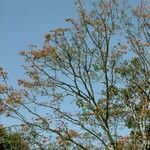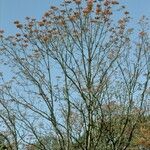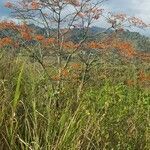Large trees, often armed. Leaves with the leaflets rhomboid or deltoid, deltoid ovate to suborbicular, 5-18 cm long, 5.5-15 cm wide, acuminate or obtuse at the apex, the base variable, thinly chartaceous, usually scabrous beneath; stipels forming stalked cups 1-4 mm long; petioles 10-30 cm long; rachises elongate. Inflorescences to 35 cm long; bracts ovate, to 1.5 mm long, ca. 0.8 mm wide, the bracteoles somewhat smaller than the bracts. Flowers with the calyx narrowly cylindrical campanulate, ca. 5 mm long and wide, the teeth absent or present as glandular points, carnose, minutely puberulent; standard scarlet, elliptic, to 50 mm long and 20 mm wide, varying from acute to obtuse apically and basally, the claw scarcely evident, the wing petals obovate or oblong, ca. 12 mm long and 5 mm wide, rounded, tapering obtusely basally, glabrous, the claw indistinct, the keel petals falcate, to 45 mm long and 10 mm wide; staminal tube 30-40 mm long, ca. 1 mm wide; pistil to 50 mm long, the stipe glabrous, the ovary linear, finely puberulent, the style filiform sigmatoid. Legume chartaceous, to 25 cm long and 1.5 cm wide, the seeds coffee colored, ca. 12 mm long.
More
A tree. It loses its leaves during the year. It grows 30 m tall. The branches have prickles and the trunk has lumps. The leaves are alternate and compound. They have 3 leaflets each 20 cm long. They are broad with a pointed tip. The flowers are 4-5 cm long. They are shaped like pea flowers. They are orange to red. The fruit is a pod. It is 10-25 cm long. The seeds are brown.
Humid and subhumid tropical lowlands, such as the riverine and upland forests of the Amazon and Orinoco Basins. Found in secondary formations, in areas not subject to inundation, favouring deep, fertile, humus-rich, clayey soils.
More
It is common in tropical America. It is a native of the Andes in Peru. It grows in the humid lowlands and up to 2,000 m above sea level. At ECHO.




